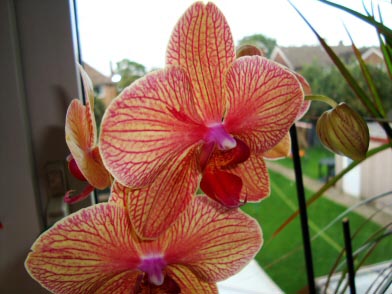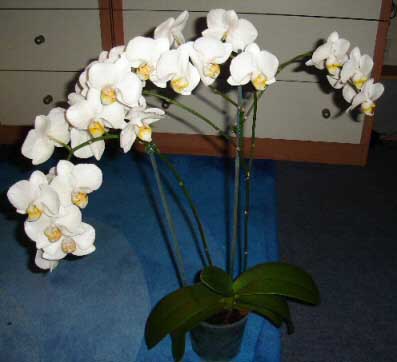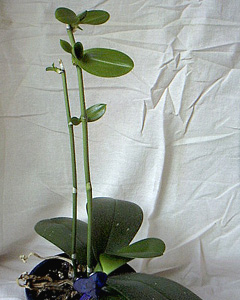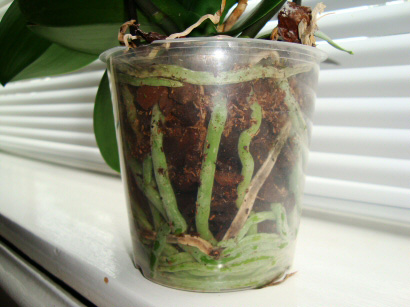





The Moth Orchid, Phalaenopsis or Phal's are very well known house plants and easily recognised today and have arguably done more to raise the popularity of orchids in general than any other genus.  Around 20 years ago Moth Orchids (along with other) were admired but considered only suitable for those with conservatories and wealth, such a plant was surely an indulgence most could not afford! Then several hybrids were created which allowed mass propagation to occur, before long they were being shipped world wide and as their popularity grew, more and more people wanted one. They now pop up everywhere from supermarkets to garage forecourts, and it's easy to see why:
Around 20 years ago Moth Orchids (along with other) were admired but considered only suitable for those with conservatories and wealth, such a plant was surely an indulgence most could not afford! Then several hybrids were created which allowed mass propagation to occur, before long they were being shipped world wide and as their popularity grew, more and more people wanted one. They now pop up everywhere from supermarkets to garage forecourts, and it's easy to see why:
The Moth Orchid is easy to get reflowering, to care for and are reasonably priced. Therefore they are the ideal orchid for beginners because in addition to the above they are perfectly suited to the home environment; with a preference for warm and shady conditions, which occurs in at least a few rooms of every home. The flowers are remarkably numerous, beautiful and long lasting, coming in an almost limitless number of colours and patterns. The common name of "Moth Orchid" derives from the shape of the flower which resembles a Moth in flight.
A small draw back of all this hybridising means some Moth Orchids  will be almost in constant flower, which is obviously beautiful to look at but comes at the plant's expense. As it spends all of its energy producing new flower spikes instead of new growth it means the plant can be quite short lived when compared to other house plants. If yours is a particular favorite, ensure it has at least 3 or 4 leaves before allowing it to flower. Should you notice a flowering spike and the plant has seen better days cut the spike off to encourage new leaf growth first.
will be almost in constant flower, which is obviously beautiful to look at but comes at the plant's expense. As it spends all of its energy producing new flower spikes instead of new growth it means the plant can be quite short lived when compared to other house plants. If yours is a particular favorite, ensure it has at least 3 or 4 leaves before allowing it to flower. Should you notice a flowering spike and the plant has seen better days cut the spike off to encourage new leaf growth first.
Light
Good light is required for Phalaenopsis but absolutely no direct sunlight or the leaves will scorch. Rotate the plant from time to time to keep growth equal.
Watering
The orchid must never "sit" in water. It will need watering perhaps once or twice a week in very hot months of the year and less in colder ones. If you need some help to know when to water your Moth Orchid, assuming the plant is in a clear pot (see the Anything else section below) meaning you can see them, the roots inside the pot will be vivid green when they are well watered. The green will fade and look more silvery when dry. Roots outside of the pot will always be silver unless humidity is high.
Humidity
High humidity will decrease the frequency of watering, and it's essential if the plant is perhaps attached to a "mount" instead of sitting in a pot. Otherwise unless you have very dry air you wont need to worry too much about humidity.
Feeding
You can get special Orchid feeds, however most anyway are very weak versions of an all purpose fertiliser. If any case, just a feed every few weeks will be more than adequate.
Temperature
The plant needs a warm spot, 13 °C - 29 °C / 55°F - 85°F. Traditional wisdom stated to get new flower spikes you needed to have a high day time temperature and a low night time temperature i.e. a "swing". However experiments have shown a warm room that does not exceed 27°C / 81°F during the day will help trigger new flower spikes.
Repotting
Moth Orchids usually come (and should be kept) in a potting mix which is very "airy". Typically bark is used, but anything which holds small amounts of water and minerals would be acceptable. NEVER use potting compost, this media holds far to much water and the roots would rot in a matter of weeks.
Repotting only needs doing when the bark or potting mix has broken down, or the plant "pushes" itself up and out of the pot. This could be anything from 2 to 3 years. You can get special orchid potting mixes from many places, especially larger garden centers. If you are struggling there's always Amazon.


Release the plant from its current pot (you may have to cut off some of the roots if they have escaped out of the drainage holes and hooked on), and shake off the old potting mix. Look for any dead roots, which will be black or mushy and cut them away. Then replace the old potting mix you removed with the new, it's just a case then of gently "pushing" the plant back in to the pot. If the orchid hasn't been repotted for years or it has drastically pushed out of the pot you may have to consider moving to a new container one size up.
If the above doesn't make sense or you're having problems check out YouTube for lots of visual how to videos.
Propagation
Orchids  are propagated by seed, however this method isn't for the average owner because it's expensive and time consuming. It's much more cost effective to increase your collection by going out and buying more! Periodically the plant will naturally produce "baby" orchids known as keiki's, these are identical copies of the parent and appear typically on either an old or new flower spike.
are propagated by seed, however this method isn't for the average owner because it's expensive and time consuming. It's much more cost effective to increase your collection by going out and buying more! Periodically the plant will naturally produce "baby" orchids known as keiki's, these are identical copies of the parent and appear typically on either an old or new flower spike.
Once it is old enough you can remove the keiki from the parent and pot up in its own pot. Bear in mind it can take a year or more before the keiki can be separated. It will be ready when the new plant has 2 or 3 leaves and several roots with the largest being about 3 inches long.
Speed of Growth
Slow. A mature Moth Orchid can expect to get 1 to 3 new leaves a year with an equal number of lower leaves yellowing and dropping off. The number of flower spikes and the frequency that you get them during the year will vary depending on the plant itself and the growing conditions.
Height / Spread
The plant itself will normally reach up to 20cm / 8in in height and about 30cm / 12 in spread. The flower spike however can reach unbelievable lengths. Use house plant sticks to support very long spikes.
Flowers
If you meet the growing conditions above your Moth Orchid should produce several flushes of flowers each year. If you become obsessed a fan of these orchids and you amass a collection, you will notice they have their own personalities. Some will produce several flower spikes at once, some will have just one spike at a time and others still will tend to keep extending the same spike over and over until it becomes incredibly long.
Anything else?
As well as being pretty to look at the roots contain chlorophyll therefore photosynthesis occurs here as well as in the leaves. There are two schools of thought about what type of pot the plant should be placed in:
"Clear Pots - It's important to make sure the pot is in a clear plastic pot to let light reach the roots.  Light equals more photosynthesis which in turn means a more robust plant and greater probability of flowers. This best reflects the conditions of orchids growing in their native habitat. A clear pot also shows you the roots at all times and allows you judge when it's time to water".
Light equals more photosynthesis which in turn means a more robust plant and greater probability of flowers. This best reflects the conditions of orchids growing in their native habitat. A clear pot also shows you the roots at all times and allows you judge when it's time to water".
"Normal Plant Pot - The plant will adapt if light doesn't reach the roots. The adaptation will result in the leaves becoming a slightly darker green and producing more leaves than a plant in a clear pot".
The Our House Plants.com team recommend clear pots where possible especially for less experienced owners as over watering is a common problem in pots where you cant see the roots.
Copyright © www.100flowers.win Botanic Garden All Rights Reserved